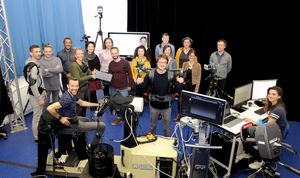KANBrief 3/19

The use of exoskeletons and other equipment in companies to support physical work has been growing for some time now. This equipment is intended to ease strenuous tasks and to support the wearer. The companies using exoskeletons hope that they will permit solutions by which musculoskeletal diseases can be avoided. This raises the question however to what extent exoskeletons are accepted by the workers themselves. A study conducted by the french occupational health and safety Institute INRS (l’Institut national de recherche et de sécurité) has examined this aspect.
The aim of the study was to understand the process of acceptance and the interaction between operator and exoskeleton, and based on the results, to formulate recommendations for occupational safety and health. To this end, a questionnaire was drawn up for completion by persons in several companies, in a range of sectors, who were using exoskeletons or had used them in the past. Interviews were also held in the companies at various levels (senior management, middle management, OSH professionals).
The results of the questionnaires showed the introduction phase to be crucial to how an exoskeleton is received. The interviews however showed that users were often not involved sufficiently – if at all – during this phase, owing to the speed with which exoskeletons were introduced in the companies. Often, little time was allowed for familiarization and training, which is not conducive to acceptance. In order to improve the underlying conditions for the introduction of exoskeletons from an occupational safety and health perspective, the INRS provides a guide for labour inspectors and companies.
A majority of the persons questioned are seen to consider the introduction and use of exoskeletons in principle to be straightforward. Irrespective of whether the workers were ultimately in favour of using the exoskeleton, they also stated that they did not tire any less with the exoskeleton than without it. They did state however that exertion was lower with use of the exoskeleton.
The productive performance is evidently not a decisive criterion for using or not using exoskeletons: all users stated that it remained unchanged by the use of exoskeletons.
With regard to the social factors, all workers stated that their wearing an exoskeleton was not well received by colleagues. This makes the process of acceptance difficult, and raises the question above all what effects this technology has upon cooperation and collegiality within the company.
Some employees stated that they felt constrained in their mobility when wearing an exoskeleton, and were forced to readjust it regularly. This may suggest that the selected item of equipment was unsuitable for the task, or not ideally designed for it.
Others stated that new complaints or pain arose in parts of the body that were not supported by the exoskeleton. Even some of the wearers who feel that the exoskeleton is suitable in principle for use at their work emphasize that it is not comfortable to wear and that they do not enjoy working with it. In these cases, the equipment appears to be regarded more as a hindrance than an aid. Ultimately, these points of criticism are obstacles to acceptance, even when the workers are positively disposed to the equipment in other respects.
To summarize: the process of acceptance is dynamic, complex and vulnerable, and is dependent upon numerous different factors. Even when workers accept the technology, it does not automatically follow that they view all of these factors positively. Some points are however indispensable, such as the aspect of safety and health, and that of ease of use. If a new form of technology is imposed without being accepted, it may give rise to psychosocial and physical risks and increase the risk of accidents. The INRS is continuing its work on this issue and will supplement these preliminary results with a second survey round on a larger scale.
Liên Wioland, Latifa Debay, Jean-Jacques Atain-Kouadio
lien.wioland@inrs.fr